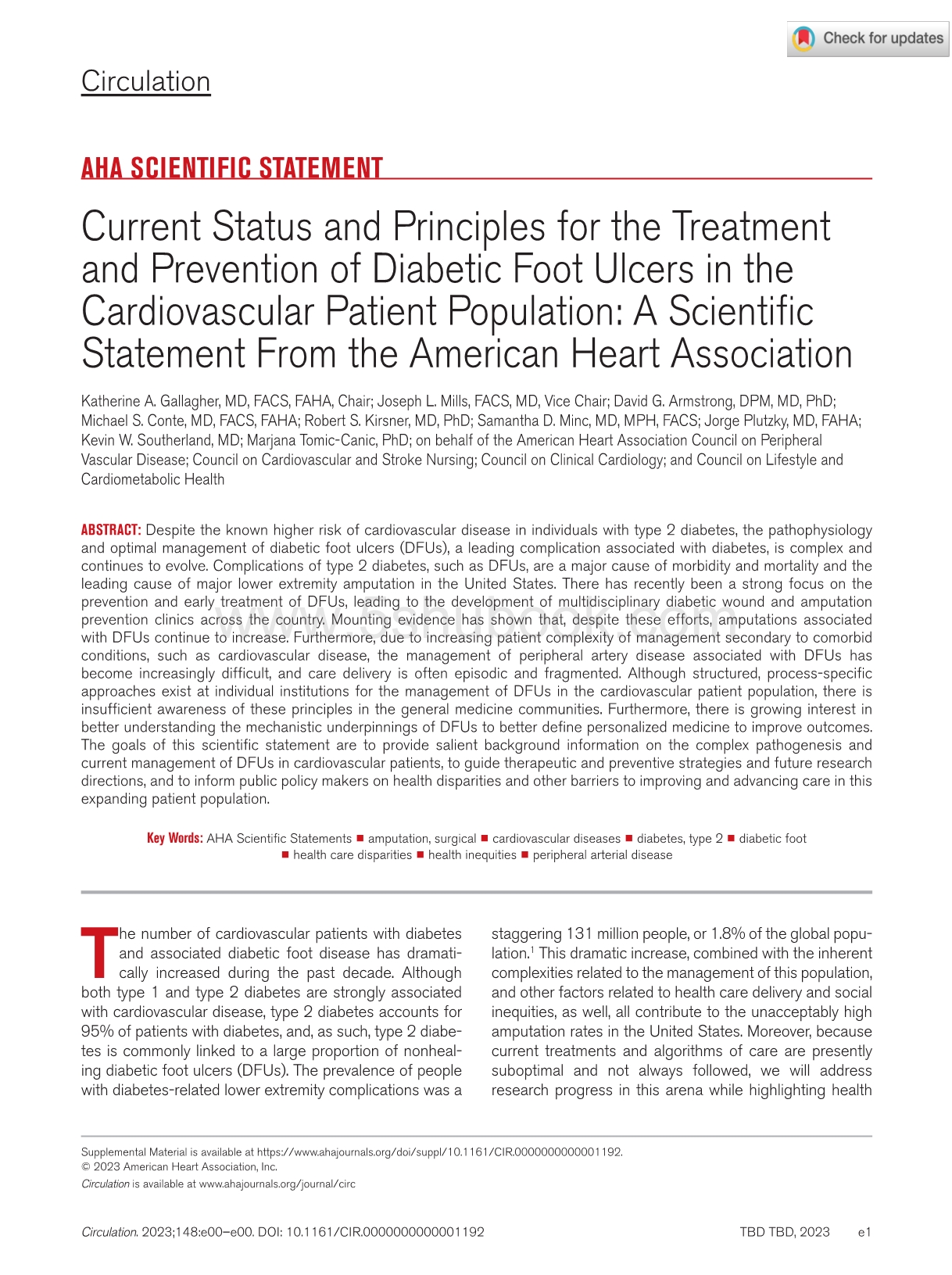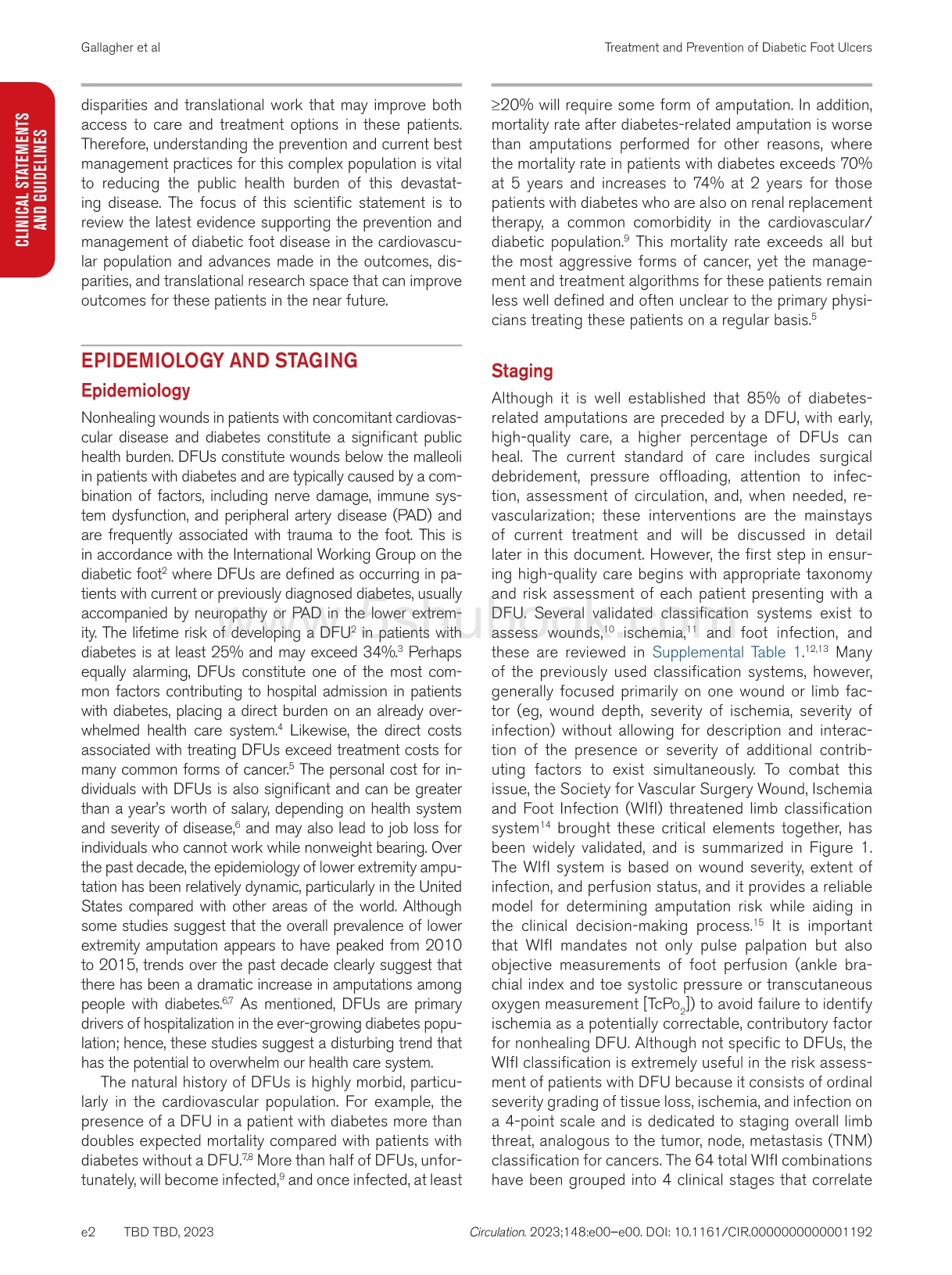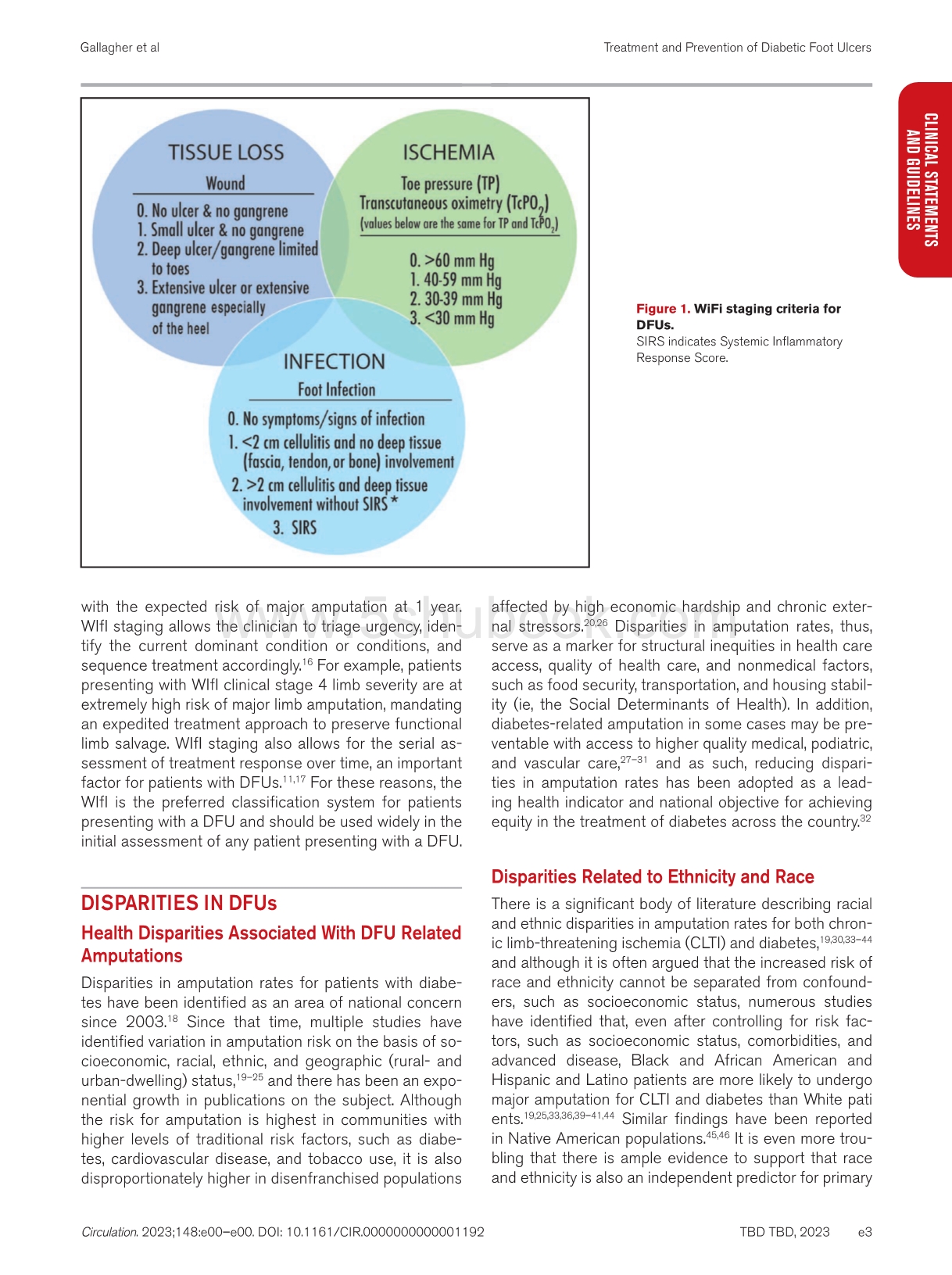
 2023+AHA科学声明:心血管患者群体中糖尿病足溃疡的现状及防治原则(英文版).pdf
2023+AHA科学声明:心血管患者群体中糖尿病足溃疡的现状及防治原则(英文版).pdf
《2023+AHA科学声明:心血管患者群体中糖尿病足溃疡的现状及防治原则(英文版).pdf》由会员分享,可在线阅读,更多相关《2023+AHA科学声明:心血管患者群体中糖尿病足溃疡的现状及防治原则(英文版).pdf(22页珍藏版)》请在周易易学书店|道易五术书社上搜索。
1、CirculationCirculation.2023;148:e00e00.DOI:10.1161/CIR.0000000000001192 TBD TBD,2023 e1Circulation is available at www.ahajournals.org/journal/circ Supplemental Material is available at https:/www.ahajournals.org/doi/suppl/10.1161/CIR.0000000000001192.2023 American Heart Association,Inc.AHA SCIENTIF
2、IC STATEMENTCurrent Status and Principles for the Treatment and Prevention of Diabetic Foot Ulcers in the Cardiovascular Patient Population:A Scientific Statement From the American Heart AssociationKatherine A.Gallagher,MD,FACS,FAHA,Chair;Joseph L.Mills,FACS,MD,Vice Chair;David G.Armstrong,DPM,MD,Ph
3、D;Michael S.Conte,MD,FACS,FAHA;Robert S.Kirsner,MD,PhD;Samantha D.Minc,MD,MPH,FACS;Jorge Plutzky,MD,FAHA;Kevin W.Southerland,MD;Marjana Tomic-Canic,PhD;on behalf of the American Heart Association Council on Peripheral Vascular Disease;Council on Cardiovascular and Stroke Nursing;Council on Clinical
4、Cardiology;and Council on Lifestyle and Cardiometabolic HealthABSTRACT:Despite the known higher risk of cardiovascular disease in individuals with type 2 diabetes,the pathophysiology and optimal management of diabetic foot ulcers(DFUs),a leading complication associated with diabetes,is complex and c
5、ontinues to evolve.Complications of type 2 diabetes,such as DFUs,are a major cause of morbidity and mortality and the leading cause of major lower extremity amputation in the United States.There has recently been a strong focus on the prevention and early treatment of DFUs,leading to the development
6、 of multidisciplinary diabetic wound and amputation prevention clinics across the country.Mounting evidence has shown that,despite these efforts,amputations associated with DFUs continue to increase.Furthermore,due to increasing patient complexity of management secondary to comorbid conditions,such
7、as cardiovascular disease,the management of peripheral artery disease associated with DFUs has become increasingly difficult,and care delivery is often episodic and fragmented.Although structured,process-specific approaches exist at individual institutions for the management of DFUs in the cardiovas
8、cular patient population,there is insufficient awareness of these principles in the general medicine communities.Furthermore,there is growing interest in better understanding the mechanistic underpinnings of DFUs to better define personalized medicine to improve outcomes.The goals of this scientific
9、 statement are to provide salient background information on the complex pathogenesis and current management of DFUs in cardiovascular patients,to guide therapeutic and preventive strategies and future research directions,and to inform public policy makers on health disparities and other barriers to
10、improving and advancing care in this expanding patient population.Key Words:AHA Scientific Statements amputation,surgical cardiovascular diseases diabetes,type 2 diabetic foot health care disparities health inequities peripheral arterial diseaseThe number of cardiovascular patients with diabetes and
11、 associated diabetic foot disease has dramati-cally increased during the past decade.Although both type 1 and type 2 diabetes are strongly associated with cardiovascular disease,type 2 diabetes accounts for 95%of patients with diabetes,and,as such,type 2 diabe-tes is commonly linked to a large propo
12、rtion of nonheal-ing diabetic foot ulcers(DFUs).The prevalence of people with diabetes-related lower extremity complications was a staggering 131 million people,or 1.8%of the global popu-lation.1 This dramatic increase,combined with the inherent complexities related to the management of this populat
13、ion,and other factors related to health care delivery and social inequities,as well,all contribute to the unacceptably high amputation rates in the United States.Moreover,because current treatments and algorithms of care are presently suboptimal and not always followed,we will address research progr
14、ess in this arena while highlighting health CLINICAL STATEMENTS AND GUIDELINESTBD TBD,2023 Circulation.2023;148:e00e00.DOI:10.1161/CIR.0000000000001192Gallagher et al Treatment and Prevention of Diabetic Foot Ulcerse2disparities and translational work that may improve both access to care and treatme
15、nt options in these patients.Therefore,understanding the prevention and current best management practices for this complex population is vital to reducing the public health burden of this devastat-ing disease.The focus of this scientific statement is to review the latest evidence supporting the prev
16、ention and management of diabetic foot disease in the cardiovascu-lar population and advances made in the outcomes,dis-parities,and translational research space that can improve outcomes for these patients in the near future.EPIDEMIOLOGY AND STAGINGEpidemiologyNonhealing wounds in patients with conc
17、omitant cardiovas-cular disease and diabetes constitute a significant public health burden.DFUs constitute wounds below the malleoli in patients with diabetes and are typically caused by a com-bination of factors,including nerve damage,immune sys-tem dysfunction,and peripheral artery disease(PAD)and
18、 are frequently associated with trauma to the foot.This is in accordance with the International Working Group on the diabetic foot2 where DFUs are defined as occurring in pa-tients with current or previously diagnosed diabetes,usually accompanied by neuropathy or PAD in the lower extrem-ity.The life
19、time risk of developing a DFU2 in patients with diabetes is at least 25%and may exceed 34%.3 Perhaps equally alarming,DFUs constitute one of the most com-mon factors contributing to hospital admission in patients with diabetes,placing a direct burden on an already over-whelmed health care system.4 L
20、ikewise,the direct costs associated with treating DFUs exceed treatment costs for many common forms of cancer.5 The personal cost for in-dividuals with DFUs is also significant and can be greater than a years worth of salary,depending on health system and severity of disease,6 and may also lead to j
21、ob loss for individuals who cannot work while nonweight bearing.Over the past decade,the epidemiology of lower extremity ampu-tation has been relatively dynamic,particularly in the United States compared with other areas of the world.Although some studies suggest that the overall prevalence of lower
22、 extremity amputation appears to have peaked from 2010 to 2015,trends over the past decade clearly suggest that there has been a dramatic increase in amputations among people with diabetes.6,7 As mentioned,DFUs are primary drivers of hospitalization in the ever-growing diabetes popu-lation;hence,the
23、se studies suggest a disturbing trend that has the potential to overwhelm our health care system.The natural history of DFUs is highly morbid,particu-larly in the cardiovascular population.For example,the presence of a DFU in a patient with diabetes more than doubles expected mortality compared with
24、 patients with diabetes without a DFU.7,8 More than half of DFUs,unfor-tunately,will become infected,9 and once infected,at least 20%will require some form of amputation.In addition,mortality rate after diabetes-related amputation is worse than amputations performed for other reasons,where the morta
25、lity rate in patients with diabetes exceeds 70%at 5 years and increases to 74%at 2 years for those patients with diabetes who are also on renal replacement therapy,a common comorbidity in the cardiovascular/diabetic population.9 This mortality rate exceeds all but the most aggressive forms of cancer



- 配套讲稿:
如PPT文件的首页显示word图标,表示该PPT已包含配套word讲稿。双击word图标可打开word文档。
- 特殊限制:
部分文档作品中含有的国旗、国徽等图片,仅作为作品整体效果示例展示,禁止商用。设计者仅对作品中独创性部分享有著作权。
- 关 键 词:
- aha 科学 声明 心血管 患者 群体 糖尿病足 溃疡 现状 防治 原则
 周易易学书店|道易五术书社所有资源均是用户自行上传分享,仅供网友学习交流,未经上传用户书面授权,请勿作他用。
周易易学书店|道易五术书社所有资源均是用户自行上传分享,仅供网友学习交流,未经上传用户书面授权,请勿作他用。









 《风湿病中医特色治疗》·吴启富.pdf(342页)
《风湿病中医特色治疗》·吴启富.pdf(342页)
 【2016爱爱医中医擂台赛】:协定处方院内验方 院内制剂汇集(骨伤科类)天津市中医院.doc(2页)
【2016爱爱医中医擂台赛】:协定处方院内验方 院内制剂汇集(骨伤科类)天津市中医院.doc(2页)
 穴位贴敷疗法(中医特色治疗).ppt(14页)
穴位贴敷疗法(中医特色治疗).ppt(14页)
 (集藏)麟儿报-清-佚名(www.5shubook.com).txt
(集藏)麟儿报-清-佚名(www.5shubook.com).txt
